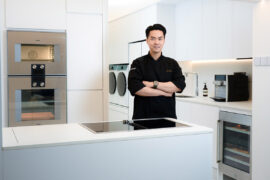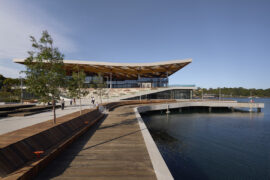The life and career of Finnish-American architect and industrial designer Eero Saarinen set the stage for some of the world’s most iconic landmarks – both in the public realm and within our very own lounge rooms and workplaces. On the 75th anniversary of his Womb Chair we take a look back over Saarinen’s career.

The Womb Chair by Eero Saarinen for Knoll, available from dedece in Australia.
August 15th, 2023
The era of Eero Saarinen design captures the imagination like no other. From the iconic Womb Chair, now turning 75, to the specular TWA Flight Centre, the ubiquitous Tulip chairs and tables, and on to the still space aged Gateway Arch (designated a National Historic Landmark in 2014), there is a streamlined beauty defining each and every piece.
Awarded the Gold Medal by the American Institute of Architects in 1962, the Finnish-born (1910) architect and industrial designer immigrated to American with his parents at 13. Proclaiming himself Finnish-American, Saarinen took courses at the Cranbrook Academy of Art, where his father was Dean.

This led to a lifelong friendship with fellow students, Charles and Ray Eames and Florence Knoll (then Schust). His studied continued at the Académie de la Grande Chaudière in Paris and then at Yale School of Architecture before a two-year gap in Africa. He then joined his father’s architectural practice.
An incredible and recognised architect in his own right, Eero Saarinen was the adamant Modernist on the committee of four that selected Jørn Utzon as the sesigner for the Sydney Opera House – thank you Saarinen!
Related: Iconic lighting design from Louis Poulsen

Making an early splash in furniture through a collaboration with Charles Eames, the Organic Chair (Vitra) was conceived in 1940 for a furniture competition organised by the Museum of Modern Art (MoMA) in New York.

A significant milestone in the designer’s careers the Organic Chair is a key work from that entire era. Conceptually and structurally based on this model, Saarinen’s Tulip Chair (Vitra) and Womb Chair each have legacies with this initial design.

As good friends with Florence Knoll, the relationship between Saarinen and Knoll the company started early with the Grasshopper Lounge Chair and Ottoman of 1943-1946. This high backed, and highly engineered lounge chair, while distinctly Saarinen and now highly collectable, was only a moderate success despite remaining in production until 1965.
It did however, set the stage for Saarinen to break from established design conventions. To set the stage, in the 1940s, chairs were prescriptive of how a woman should sit with an upright back, crossed ankles and hands neatly folded. This was all about to change.

The first to really break with tradition was the now beloved Womb Chair of 1948 (the Womb Settee followed in 1950, with side and arm chairs developed simultaneously 1948-50). Resulting from a request from his good friend and collaborator Florence Knoll, the then-head of design at Knoll, Florence Knoll was a pioneer in her creative vision, combining a feminist instinct and boundary-pushing foresight into the design legacy of Knoll for years to come.
Challenging the standard offering of chairs in defiance of the status quo, she recalls yearning for a chair like a basket full of pillows – something she could curl up in: “I told Eero I was sick and tired of the one-dimensional lounge chairs… long and narrow. I want a chair I can sit sideways in or any other way I want.” In response, Saarinen developed a chair with a sweeping backrest and ample armrests, accommodating the comforting cup-like effect Florence Knoll desired.

As to the name… “It was designed on the theory that a great number of people have never really felt comfortable and secure since they left the womb,” Saarinen once explained (Ref). “The chair is an attempt to rectify this maladjustment in our civilisation,” says Saarinen of the iconic chair presented in the US Pavilion in the 1951 Milan Triennale. He adds, “There seemed to be a need for a large and really comfortable chair to take the place of the old overstuffed chair. . . . Today, more than ever before, we need to relax.”
In combining his friend’s request with the streamlined and funky shape, he delivered what has remained one of the best lounge chairs for contemporary interior design, and one of the few chairs suited for reading a book.

“Knoll’s Womb Chair has remained a beloved design piece for generations,” says John Engelen, founder of dedece. “The chair’s iconic status is a testament to Florence Knoll and Eero Saarinen’s design foresight and exceptional attention to detail.
“dedece proudly shares in the celebration of this significant milestone of the influential Womb Chair,” says Engelen of dedece where the Womb Chair is exclusively available in Australia.

The early design for the Womb, using Saarinen’s preferred material, moulded plywood, presented issues in that the chair’s size would stretch the material beyond its capabilities. After many iterations and prototypes, a fibreglass shell presented itself as the perfect material to complement the chair’s unique structure and the stepping stone to his next designs.
The arc of this trajectory and arguably the most coveted of all iconic mid-century furniture was the Tulip group (pedestal Group) of 1956. This insouciant delight is an extraordinary piece of engineering where nothing is in excess, nothing clutters the form and the pared back shape is fluid and perfectly tuned to the body.

The seat was also considerably higher than much mid-century furniture and remains unchanged and uncompromised for being so. With side and arm chairs, dining (round and oval), coffee, side tables and stool, it was also a suite of furniture, that could instantly transform a home with elegant and proportionally balanced design.
At 75, the Womb Chair remains one of the most treasured of Saarinen, and indeed the entire cannon of mid-century, design. In a way, the design is so evocative of the tenets of modernism that it has become era proof, instead fitting well with contemporary, modernist and eclectic design languages that range from minimalist to maximalist. Colour and fabric selections to some extent ensure its continued longevity, but, that shape, remains a beacon of desirability and deliciously relaxed luxury.

We think you might also like to read about this story on Pedrali’s widest and most chair successful collections.
INDESIGN is on instagram
Follow @indesignlive
A searchable and comprehensive guide for specifying leading products and their suppliers
Keep up to date with the latest and greatest from our industry BFF's!

For those who appreciate form as much as function, Gaggenau’s latest induction innovation delivers sculpted precision and effortless flexibility, disappearing seamlessly into the surface when not in use.

For a closer look behind the creative process, watch this video interview with Sebastian Nash, where he explores the making of King Living’s textile range – from fibre choices to design intent.

Now cooking and entertaining from his minimalist home kitchen designed around Gaggenau’s refined performance, Chef Wu brings professional craft into a calm and well-composed setting.

Merging two hotel identities in one landmark development, Hotel Indigo and Holiday Inn Little Collins capture the spirit of Melbourne through Buchan’s narrative-driven design – elevated by GROHE’s signature craftsmanship.

Australia Post’s new Melbourne Support Centre by Hassell showcases circular design, adaptive reuse and a community-focused approach to work.

Signalling a transformative moment for Blackwattle Bay and the redevelopment of Sydney’s harbour foreshore, the newly open Sydney Fish Market demonstrates how thoughtfully designed public realm and contemporary market space can unite to create a landmark urban destination.
The internet never sleeps! Here's the stuff you might have missed

Knoll unveils two compelling chapters in its uncompromising design story: the Perron Pillo Lounge Chair and new material palettes for the Saarinen Pedestal Collection.

J.AR OFFICE’s Norté in Mermaid Beach wins Best Restaurant Design 2025 for its moody, modernist take on coastal dining.